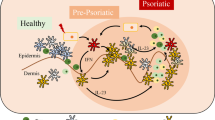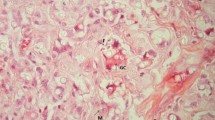Summary
We examined the time-dependent dynamics of epidermal Langerhans' cells (LC) in human systemic lupus erythematosus (SLE), in MRL/Mp-lpr/lpr (MRL/lpr) mice, and in various experimental cutaneous inflammations, such as the Arthus reaction, dinitrochlorobenzene allergic dermatitis, and croton oil primary irritant dermatitis, in order to clarify the pathomechanisms of lupus skin lesions. The numbers of LC in untreated SLE patients with newly developed skin lesions decreased in the central lesional sites and increased significantly in the peripheral lesional sites. In MRL/lpr mice, the number of LC increased significantly in the central lesional sites during the initial stage and increased in the peripheral lesional sites and decreased in the central lesional sites 2–4 weeks after the onset of skin lesions. In contrast, with experimental cutaneous inflammations of guinea pigs, the increase in numbers of LC in the peripheral lesional sites was not significant during the time course of the reaction. These results suggest that the increased numbers of LC during the active and early stages of skin lesions in human SLE and MRL/lpr mice are closely related to the specific spontaneous development of skin lesions, unlike the dynamics of LC in experimental cutaneous inflammations.
Similar content being viewed by others
References
Aberer W, Stingl G, Stingl-Gazze LA, Wolff K (1982) Langerhans' cell as stimulator cells of the murine primary epidermal cellplymphocyte reaction: alteration by UV-B irradiation. J Invest Dermatol 79:129–135
Bergstresser PR, Fletcher CR, Streilein JW (1980) Surface densities of Langerhans' cells in relation to rodent epidermal sites with special immunologic properties. J Invest Dermatol 74:77–80
Braathen LR, Thorsby E (1980) Studies on human epidermal Langerhans' cells express Ia antigens. Nature 268:248–250
Braathen LR, Thorsby E (1980) Studies on human epidermal Langerhans' cells. I. Allo-activating and antigen-presenting capacity. Scand J Immunol 11:401–408
Burnham TK, Neblett TR, Fine G (1963) The application of the fluorescent antibody technic to the investigation of lupus erythematosus and various dermatoses. J Invest Dermatol 41:451–456
Furukawa F, Hamashima Y (1982) Lupus band test in New Zealand mice and MRL mice. J Dermatol 8:467–471
Furukawa F, Tanaka H, Sekita K, Nakamura T, Horiguchi Y, Hamashima Y (1984) Dermatopathological studies on skin lesions of MRL mice. Arch Dermatol Res 276:186–194
Horiguchi Y, Furukawa F, Hamashima Y, Imamura S (1984) Ultrastructural observations of skin lesions in MRL mice, dermoepidermal junction. Arch Dermatol Res 276: 229–234
Horiguchi Y, Furukawa F, Hamashima Y, Imamura S (1986) Ultrastructural lupus band test in skin of MRL/l mice. Arch Dermatol Res 278:474–480
Imamura S, Tachibana T, Taniguchi S (1985) Impaired histamine metabolism in the Arthus reaction induced in guineapig skin. Arch Dermatol Res 277:313–317
Juhlin L, Shelley WB (1977) New staining techniques for the Langerhans' cell. Acta Dermatol Vernereol 57:289–296
Kanauchi H, Furukawa F, Horiguchi Y, Horio T, Imamura S (1988) Distribution of Langerhans' cells in skin lesions of MRL/lpr mice. Arch Dermatol Res 280:327–331
Kanauchi H, Furukawa F, Horiguchi Y, Imamura S (1988) Quantitative studies on Langerhans' cell population in skin lesions of murine and human SLE. J Invest Dermatol 90:573A
Murphy ED, Roths JB (1978) Autoimmunity and lymphoproliferation. Induction by mutant gene lpr, and acceleration by a malate-associated factor in strain BXSB mice. In: Bigazzi PE, Warner NL (eds) Genetic control of autoimmune disease. Elsevier North-Holland, New York, pp 207–221
Rowden G, Lewis MG, Sullivan AK (1977) Ia antigen expression on human epidermal Langerhans' cells. Nature 268:247–248
Schwartz RH, Jackson L, Paul WE (1975) T lymphocyte enriched murine I. A reliable assay for antigen-induced T lymphocyte proliferation. J Immunol 115:1330–1338
Sontheimer RD, Bergstresser PR (1982) Epidermal Langerhans' cell involvement in cutaneous lupus erythematosus. J Invest Dermatol 79:237–243
Stingl G, Wolff-Schreimer EC, Pichler WJ, Gschnait F, Knapp W, Wolff K (1977) Epidermal Langerhans' cells bear Fc and C3 receptors. Nature 268:245–246
Stingl G, Katz SI, Shevach EM, Rosenthal AS, Green I (1978) Analogous functions of macrophages and Langerhans' cells in the initiation of the immune response. J Invest Dermatol 71:257–258
Stingl G, Katz SI, Clement L, Green I, Shevachet EM (1978) Immunologic function of Ia-bearing epidermal Langerhans' cells. J Immunol 121:2005–2013
Tan EM, Cohen AS, Fries JF (1982) The 1982 revised criteria for the classification of systemic erythematosus. Arthritis Rheum 25:1271–1277
Toews GB, Bergstresser PR, Streilein JW, Sullivan S (1979) Epidermal Langerhans' cell density determines whether contact hypersensitivity or unresponsiveness follows skin painting with DNFB. J Immunol 124:445–453
Turk JL, Polak L (1969) Action of anti-lymphatic sera on reaction caused by immune-complex formation. Lancet I:130–131
Wolff K, Winkelmann RK (1967) Quantitative studies on the Langerhans' cell population of guinea pig epidermis. J Invest Dermatol 48:504–513
Author information
Authors and Affiliations
Additional information
This is the 16th report of a series entitled “Pathogenesis of the lupus dermatoses in autoimmune mice.”
Rights and permissions
About this article
Cite this article
Kanauchi, H., Furukawa, F. & Imamura, S. Evaluation of ATPase-positive Langerhans' cells in skin lesions of lupus erythematosus and experimentally induced inflammations. Arch Dermatol Res 281, 327–332 (1989). https://doi.org/10.1007/BF00412976
Received:
Issue Date:
DOI: https://doi.org/10.1007/BF00412976




